
The Piper PA-28 Cherokee is a family of two- or four-seat light aircraft built by Piper Aircraft and designed for flight training, air taxi and personal use. The PA-28 family of aircraft comprises all-metal, unpressurized, single-engined, piston-powered airplanes with low-mounted wings and tricycle landing gear. They have a single door on the copilot side, which is entered by stepping on the wing.

The Bowers Fly Baby is a homebuilt, single-seat, open-cockpit, wood and fabric low-wing monoplane that was designed by famed United States aircraft designer and Boeing historian, Peter M. Bowers.

The Bede BD-5 Micro is a series of small, single-seat homebuilt aircraft created in the late 1960s by US aircraft designer Jim Bede and introduced to the market primarily in kit form by the now-defunct Bede Aircraft Corporation in the early 1970s.

The Flying Flea is a large family of light homebuilt aircraft first flown in 1933.

The Aeronca L was a 1930s American cabin monoplane designed and built, in small numbers, by Aeronca Aircraft. It differed significantly from other Aeronca planes by the use of radial engines, streamlining, and a cantilever low wing.

The Royal Aircraft Factory F.E.1 was designed and built in 1910 by the pioneer designer Geoffrey de Havilland. He used it to teach himself to fly during late 1910. After De Havilland was appointed assistant designer and test pilot at the Army Balloon Factory at Farnborough in December 1910 the War Office bought the aircraft for £400. the aircraft was given the designation F.E.1

The Blériot III was an early French aeroplane built by pioneer aviators Louis Blériot and Gabriel Voisin. It was later modified and renamed the Blériot IV, but both versions failed to fly.
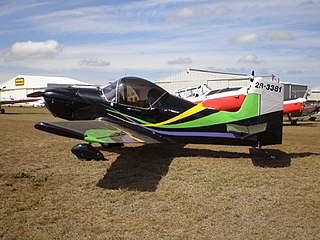
The Corby CJ-1 Starlet is a single seat, amateur-built aeroplane designed in the 1960s by Australian aeronautical engineer John Corby.
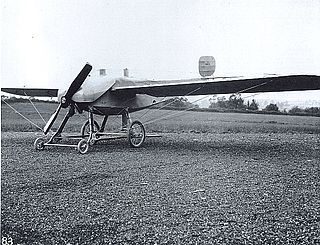
The Bristol Coanda Monoplanes were a series of monoplane trainers designed by the Romanian designer Henri Coandă for the British company British and Colonial Aeroplane Company.

The Curtiss No. 2, often known as the Reims Racer, was a racing aircraft built in the United States by Glenn Curtiss in 1909 to contest the Gordon Bennett Cup air race in Reims, France that year.
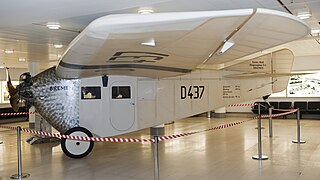
The Focke-Wulf A.16 was a German three/four passenger light transport monoplane designed by Heinrich Focke and Georg Wulf and was the first design built by the newly formed Focke-Wulf company.
The Dunne D.1, was an experimental tailless aircraft built in the United Kingdom in 1907. It comprised a main unit which could be flown as a glider, to which a chassis unit with power train could be added. The glider achieved a short flight in 1907. The D.1 was later rebuilt as the powered D.4, which achieved short hops in 1908.
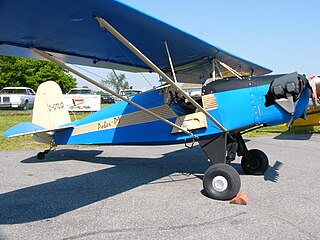
The Pober Pixie is a single-seat light aircraft that was designed in the United States in 1974 and marketed as plans for homebuilding.
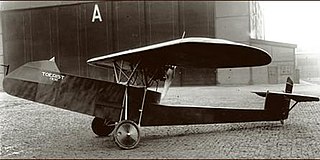
The Koolhoven F.K.30 Toerist was a small sport aircraft built in the Netherlands in 1927, intended for use by aeroclubs. The fuselage carried the pilot and one passenger in tandem in a bathtub-like open cockpit. The cantilever parasol wing was mounted above and behind them, with the main wheels of the fixed undercarriage directly below the wing, at the sides of the fuselage. The engine, driving a pusher propeller, was mounted on the aircraft centerline at the aft portion of the wing. The conventional empennage was carried on a boom extending below the propeller arc. The wing, including engine, was designed so that it could be pivoted 90° while on the ground, allowing the aircraft to be stored and transported more easily.
The Sage Type 2 was a prototype British two-seat fighter aircraft of the First World War. A single-engined biplane with an enclosed cabin for its crew, only a single example was built, as more advanced aircraft became available.
The Royal Aircraft Factory S.E.4 was a single-engined, single seat biplane designed and built at the Royal Aircraft Factory just prior to the start of the First World War. Intended to be as fast as possible, it recorded a speed of 135 mph (217 km/h), which made it the fastest aircraft in the world in 1914, but no production followed and it was soon written off in a crash.

The Smith DSA-1 Miniplane is a single-seat, single-engine sport aircraft designed in the United States in the 1950s and marketed for home building.

The Vickers R.E.P. Type Monoplanes were a series of single-engined monoplane aircraft built by Vickers prior to the outbreak of the First World War. They were developed from a French design for which Vickers had purchased a license, with eight being built.
The Hamburger Flugzeugbau Ha 136 was an all-metal, single-seat training monoplane. It was the first design for the company by Dr. Richard Vogt and the first to feature his trademark tubular steel wing spar which doubled as the main fuel tank. Two prototypes were built but it was not ordered into production.
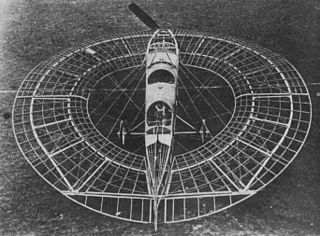
During the pioneer years before the First World War, Cedric Lee and G. Tilghman Richards in the UK built and flew a series of aircraft having a novel flat ring-shaped or annular wing. They built both biplane and monoplane types, and in 1913 their first monoplane proved to be an early example of a statically stable aircraft.

















